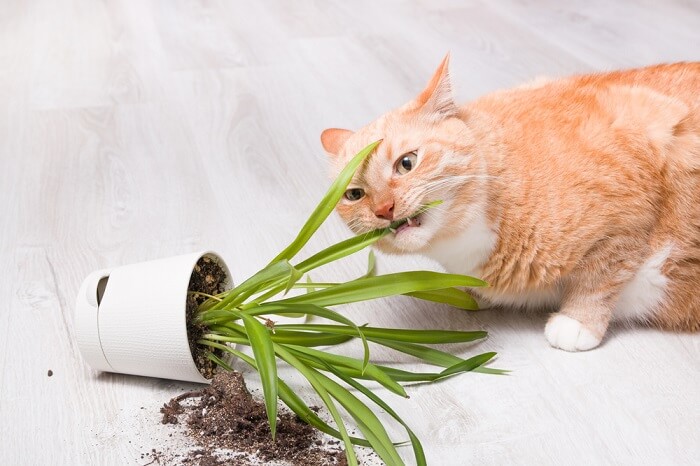
Shutterstock.com
Does your cat display peculiar behavior like licking or chewing fabric, bags, cables, rubber, plants, straws, cardboard, and household objects?
Rest assured you’re not alone. Some days, our lounge resembles a paper shredding factory and our blinds have bite mark dents. Don’t even mention plastic bags—they’re the flavor of this month.
Cats who obsessively lick, nibble, or consume non-food items are exhibiting a form of pica.
What Is Pica in Cats?
Pica involves the ingestion of non-food items. Frequently reported items that cats may chew include wool, fabric, wood, plastic, paper, and plants (Case, 2003, Horwitz & Mills 2009). Often the molar teeth are used to chew holes in such materials.
Pica shouldn’t be mistaken for the kitten behavior of suckling, which might persist into adulthood. When adult cats exhibit suckling behaviors, the material isn’t consumed, simply sucked repetitively and often accompanied by front paw kneading.
Likewise, many young kittens will chew and tear at objects when exhibiting predatory behavior during play. In this case, pieces are torn off but not consumed.
Ingestion of strange objects can result in life-threatening internal blockages that require urgent veterinary medical attention.
Why Do Cats Get Pica? Hypothesized Causes of Pica Explained
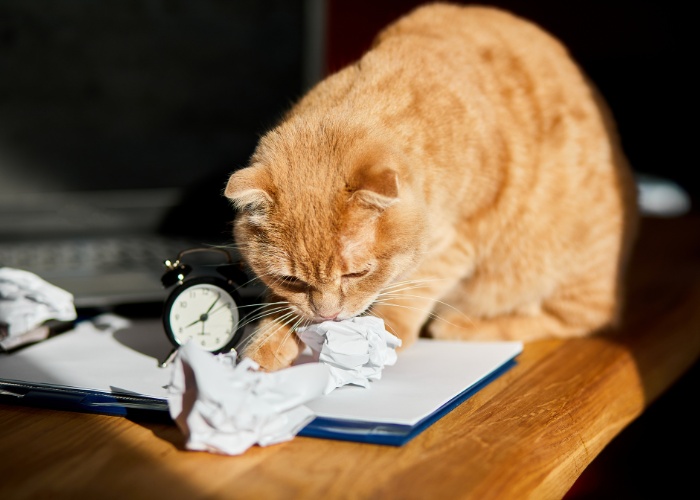
Cats know that meowing will get you to look at them, and making crinkling sounds can accomplish the same goal. Shutterstock.com
Since there’s no test to diagnose pica, veterinary professionals depend on your observations at home. Theories on the cause of pica include:
Genetics
Pica is most often seen in breeds like Siamese, Tonkinese, and Burmese, which are all predisposed to eating or sucking on wool. Domestic short hairs and Ragdolls may also develop pica.
Dietary Deficiencies
Cats with prolonged nutritional deficiencies, such as adequate fat, minerals, or vitamins in their food, may ingest non-edible material. Other cases could also be due to dietary imbalance from a lack of roughage, although a clear dietary cause has yet to be documented.
Medical Reasons
Licking or absorption of weird substances has been correlated to Endocrine and Gastrointestinal conditions, such as hyperthyroidism, diabetes, inflammatory bowel disease (IBD), gastric motility, and hookworm infestation.
Two studies uncovered a high prevalence of pica diagnosed in cats with immune-mediated Hemolytic Anemia, Pyruvate kinase deficiencies, and Feline Infectious Peritonitis (FIP), but with lower occurrences (Isabelle Demontigny-Bédard, 2015). Infrequently, eating inappropriate things may also stem from medical issues like fatty liver disease.
Additionally, neurological disorders and cancer can disrupt appetite control and contribute to uncommon cravings resulting in pica.
Pica prevalence is considerably greater in felines housed exclusively indoors. Potential contributing factors include boredom, anxiety, frustration, and lack of social contact.
Obsessive-Compulsive Disorder
According to certain literature, pica may be considered an obsessive-compulsive disorder in anxious cats. Gnawing or sucking on objects releases endorphins and serves as comfort.
Distress can exacerbate pre-existing pica and chomping of things is also used as a coping mechanism.
Stressful life events like house move, new pet adoption and owner death can trigger compulsive ingestion of non-food items in individual cats.
Symptoms of Pica in Cats
If your cat suffers from pica, they must be closely monitored. Watch out for the subsequent gastrointestinal signs just in case of blockages:
- Vomiting
- Constipation
- Diarrhea
- Lethargy
- Changes in eating patterns (decreased appetite)
Is Pica in Cats Dangerous?
Since Pica is defined as the compulsive eating behavior where cats consume non-food items such as fabric, plastic, rubber, paper, cardboard, soil, string, and plants, ingesting these non-traditional items can lead to various health risks for cats, including gastrointestinal obstruction, toxicity, choking hazards, and dental issues.
How to Treat Pica in Cats
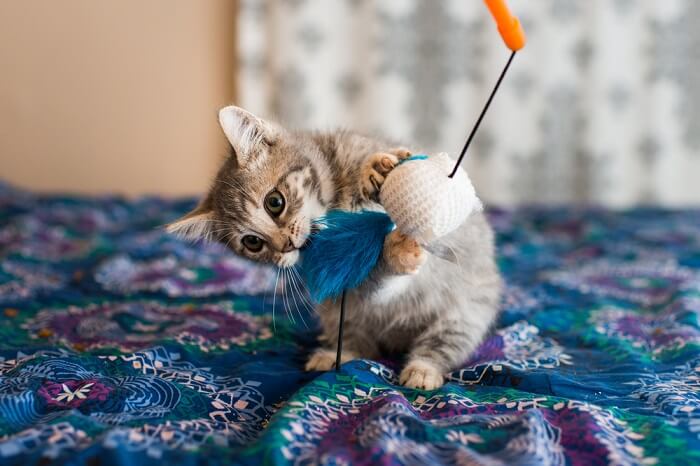
Pica may be caused by both behavioral and physical issues, so you must rule out health problems before pursuing behavior-focused treatment. Shutterstock.com
Rule out any medical conditions with a thorough vet examination before seeking a behavioral evaluation. Therapy options for mild cases:
Minimise Exposure to the Substance
- Removing the item from view could be a sufficient measure in simple cases to manage the problem.
- Minimise access to plants by placing them outside, hide plastic bags in cupboards, keep clothes together with socks in drawers, and manage the environment to reduce enticement to preferred substances.
Stress Reduction
- Create a haven with escape routes in addition to comfortable sanctuaries for retreat.
- Provide consistent daily social interaction, ensuring your cat has full control and is able to escape when they feel threatened.
- Use a variety of coping strategies and rotation in multi-cat situations to assist non-related adult cats in successfully getting along.
Boost Environmental Stimulation
- Boost your cat’s surroundings by adding vertical space like a catwalk.
- Incorporate frequent play sessions to increase environmental stimulus, especially for young kitties with a high exploratory drive.
- Redirect and motivate undesirable behavior with the help of interactive prey-type toys and clicker training.
- Build a catio or a bird feeding station for your cat’s viewing satisfaction and to alleviate boredom and frustration.
Alternate Feeding Methods
- Introduce puzzle feeders to encourage foraging with hidden food.
- Oral stimulation with the aid of cat grass, dental chews, and durable munch toys can help redirect their instinctive prey drive.
Dietary Modification and Supplementation
Cats with pica benefit from a dietary modification to a high fiber content diet. Try introducing probiotics, digestive enzymes, or a half-teaspoon of psyllium husks in wet food.
Other felines may like to change to a more natural raw diet with fibrous muscle and organ tissue. Always talk to your vet about an appropriate diet, especially for cats with GI issues.
Compulsive Behaviour
If pica is a compulsive behavior, refer to a certified behavior specialist, since medication might have to be contemplated.
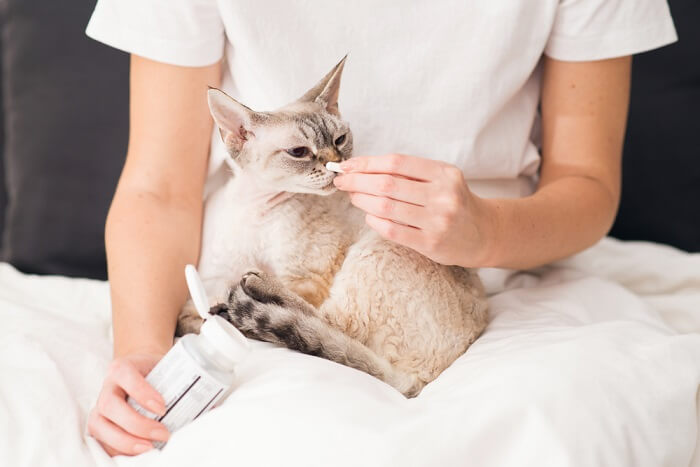
Dietary supplementation and other modifications can help to resolve any deficiencies that may lead to pica. Shutterstock.com
Pica can cause owners emotional distress, expensive vet surgery, and even pet relinquishment. Consumption of inedible material requires veterinary intervention and behavioral therapy. Although pica may be a lifelong disorder, it can be managed or resolved with appropriate toys, environment, and diet modification.
Frequently Asked Questions:
Why is my cat suddenly chewing on everything?
This can be due to stress, anxiety, diet change, intestinal parasites, or another medical cause. Cats consuming substances due to medical reasons will likely exhibit additional symptoms that signal they’re unwell requiring veterinary examination.
Will my cat outgrow chewing?
Pica in cats can start as early as 12 weeks and many of these cats will grow out of it by 1–2 years old. For others, the habit will continue into adulthood or even become life-long.
What should I feed my cat with pica?
Cats with pica may benefit from a high-fiber diet. You can also try introducing probiotics and appropriate chew toys. Consult your vet to make sure your pet gets the best nutritional care possible.
-
Care, I. C. (2018, September 26). Pica in Cats. Retrieved March 12, 2021, from ICatCare: https://icatcare.org/advice/pica-in-cats/
-
Center, C. U. (2015, October). Retrieved March 09, 2021, from CatWatch: https://www.catwatchnewsletter.com/health/when-they-ingest-non-food-objects/
-
Isabelle Demontigny-Bédard, G. B.-C. (2015). Characterization of pica and chewing behaviors in privately owned cats: a case-control study. Journal of Feline Medicine and Surgery, 1-6. Retrieved March 10, 2021, from https://journals.sagepub.com/doi/abs/10.1177/1098612X15591589?journalCode=jfma
-
Isabelle Demontigny-Bédard, G. B.-C. (2015). Characterization of pica and chewing behaviors in privately owned cats: a case-control study. Journal of Feline Medicine and Surgery, 1-6. Retrieved March 11, 2021
-
Isabelle Demontigny-Bédard, M.-C. B. (2019, October). Medical and behavioral evaluation of 8 cats presenting with fabric ingestion: An exploratory pilot study. CVJ, 1080-1088. Retrieved March 10, 2021
-
Marta Amat, T. C. (2015). Stress in owned cats: behavioural changes and welfare implications. Journal of Feline Medicine and Surgery, 18, 577-586. Retrieved March 13, 2021, from https://journals.sagepub.com/doi/10.1177/1098612X15590867
-
Rachel M Korman,. N. (2012). A retrospective study of 180 anaemic cats: features, aetiologies and survival data. Journal of Feline Medicine and Surgery, 15, 81-90. Retrieved March 14, 2021, from https://journals.sagepub.com/doi/pdf/10.1177/1098612X12461008




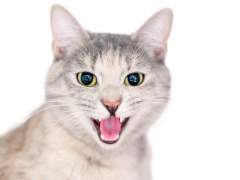
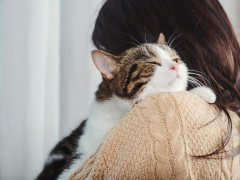
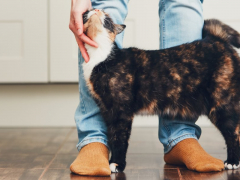

My husband uses oxygen tanks on a daily basis and our cat punctures the tubing by chewing on it. Can you suggest any spray or solution that I can apply to deter her actions. I’ve tried vinegar and various cooking extracts such as vanilla, almond, and peppermint to no avail. Any other suggestions would be greatly appreciated. Thank you,
I think you’ll find that this article addresses your problem a bit better and gives some solutions. The sprays aren’t very effective, in my experience, so it may work better to focus on distraction, deterring, and giving her other things to chew on and play with. Wishing you all the best!
I have a 9 year male Himalayan. I adopted a 1 year old female that was hanging with ferals. Both are neutered. My boy couldn’t wait to meet her. I kept them separated for 4 weeks, they were immediate friends; that was 3 years ago. In the past 2 years during the middle of the night my 3 year old has let out blood curtling screams/sounds and attacks my loving mellow Hymalayan. I have to jump out of bed and grab my boy close the bedroom door and take him in bed with me where he stays until morning. When I open the bedroom door they smell each other and all is well. Why is this happening?
Hi Pat,
Thank you for your question.
If this has been happening for 2 years continually same time, it’s likely your household is getting visited by either a feral/stray cat or a nocturnal animal causing redirected aggression.
When a cat is agitated or frustrated by a stimulus, they respond by redirecting the attack towards the closest target, in this case her mellow brother instead of the source.
Place a webcam or pet-camera with night vision before heading to bed to inspect both indoor/outdoor environments. If indeed you have a night visitor, close all blinds, change your shades or place a privacy window film.
Hope this helps
Melina